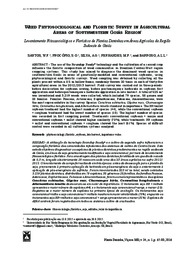Weed phytosociological and floristic survey in agricultural areas of southwestern Goiás region.
Weed phytosociological and floristic survey in agricultural areas of southwestern Goiás region.
Autoria: SANTOS, W. F.; PROCOPIO, S. de O.; SILVA, A. G.; FERNANDES, M. F.; BARROSO, A. L. L.
Resumo: The use of the Roundup Ready ® technology and the cultivation of a second cropinfluence the floristic composition of weed communities in Brazilian Central-West region cropping systems. This study has aimed to diagnose the dominant weed species in southwestern Goiás in areas of genetically-modified and conventional soybeans, using phytosociological and floristic surveys. Weed sampling was obtained by collecting all the plants present within a 0.5 m hollow frame, randomly thrown 20 times in each of thirty-five agricultural areas in the 2012/2013 harvest. Field survey was carried out in three periods: before desiccation for soybean sowing, before postemergence herbicide in soybean first application and before postemergence herbicide application in late harvest. A total of 525 m2 was inventoried and 3,219 weeds were collected, which included 79 species, 58 genera and 28 families. Families Poaceae, Asteraceae, Euphorbiaceae, Fabaceae, Amaranthaceae, were the most representative in the survey. Species Cenchrus echinatus, Glycine max, Chamaesyce hirta, Commelina benghalensis, and Alternanthera tenella stood out in importance. The RR+millet soybean treatment had the highest number of species (44), while the conventional soybean + sorghum treatment had the lowest number of species (18). The highest number of species was recorded in first sampling period. Treatments conventional soybean + maize and conventional soybean + millet showed higher similarity (70%), while treatments RR soybean + millet and conventional soybean + sorghum showed the least (51%). Species of difficult control were recorded in all cultivation systems analyzed.
Ano de publicação: 2016
Tipo de publicação: Artigo de periódico
Unidade: Embrapa Tabuleiros Costeiros
Palavras-chave: Flor, Floristic, Planta daninha
Observações
1 - Por padrão são exibidas publicações dos últimos 20 anos. Para encontrar publicações mais antigas, configure o filtro ano de publicação, colocando o ano a partir do qual você deseja encontrar publicações. O filtro está na coluna da esquerda na busca acima.
2 - Para ler algumas publicações da Embrapa (apenas as que estão em formato ePub), é necessário ter, no celular ou computador, um desses softwares gratuitos. Sistemas Android: Google Play Livros; IOS: iBooks; Windows e Linux: software Calibre.
Acesse outras publicações
Acesse a Base de Dados da Pesquisa Agropecuária (BDPA) para consultar o acervo completo das bibliotecas da Embrapa.

